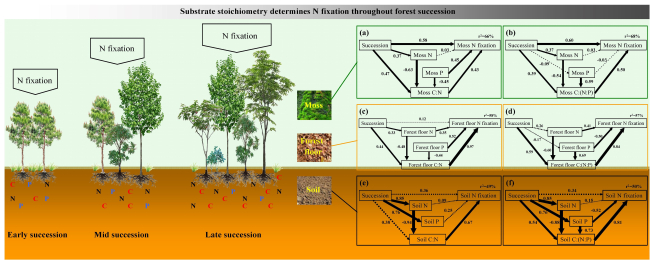Substrate stoichiometry determines nitrogen fixation throughout succession in southern Chinese forests
The traditional view holds that biological nitrogen (N) fixation often peaks in early- or mid-successional ecosystems and declines throughout succession based on the hypothesis that soil N richness and/or phosphorus (P) depletion become disadvantageous to N fixers. This view, however, fails to support the observation that N fixers can remain active in many old-growth forests despite the presence of N-rich and/or P-limiting soils.
To address how forest succession regulates N fixation and explore the mechanisms underlying such regulation, Dr. ZHENG Mianhai, under the guidance of Prof. MO Jiangming, and his colleagues from South China Botanical Garden of Chinese Academy of Sciences conducted experiments in three successional forests and in six age-gradient forests in southern China. They measured the carbon (C), N, and P concentrations and stoichiometry and N fixation rates in the soil, forest floor, and moss.
They found increases in N fixation rates in the soil, forest floor, and moss throughout three successional forests and along six age-gradient forests. Using linear regression models and structural equation models, they found that the variation in N fixation was controlled by substrate C:N and C:(N:P) stoichiometry rather than by substrate N or P.
Their findings offer an important line of evidence that N fixation rates increase throughout forest succession regardless of soil N richness and P limitation and renew our previous understanding of the highest N fixation rates occurring in early- or mid-successional forests. Moreover, their study uncovers a key mechanism driving N fixation throughout succession and stand age that labile substrate C increases rapidly compared to substrate N and N:P, which favors N fixers.
Overall, their findings help researchers understand the long-standing N paradoxical phenomenon that many lowland tropical forests rich in soil N sustain up-regulation of N cycling and highlight the utility of ecological stoichiometry in illuminating the mechanisms that couple forest succession and N cycling. The findings above have been published online in Ecology Letters (https://onlinelibrary.wiley.com/doi/full/10.1111/ele.13437).

Figure. Substrate stoichiometry determines nitrogen fixation throughout forest succession
File Download: